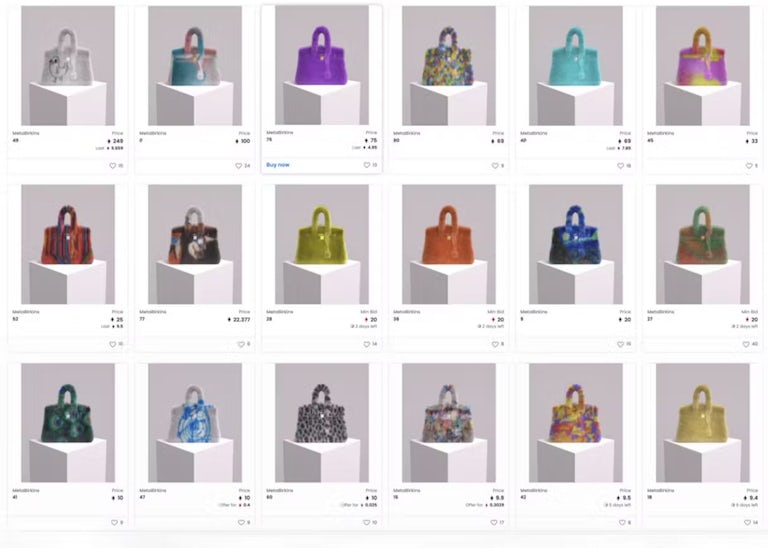Shopping Bag (0)
Your shopping bag is empty


Hermès has won a US court case against an artist whose NFTs recreated its iconic designs. What does that mean for luxury brands in the web3 space?
On February 8, a judge in New York reached a verdict in luxury brand Hermès’ case against the artist Mason Rothschild. The case pertained to Rothschild’s range of ‘MetaBirkin’ NFTs, which referenced the design of the brand’s Birkin range of brands.
The judge decided – if the name of the NFT range wasn’t enough – that Rothschild’s tokens breached three counts related to copyright, including trademark infringement, trademark dilution, and “cybersquatting,” awarding Hermès $133,000 in damages.
The case is notable for the precedent it sets relating to NFTs and their overlap with the luxury brand space. Copyright issues have been a grey area in web3 for some time, and have been a stumbling block for high-end brands who are looking to expand into web3 and metaverse commerce.
Justin Banon, co-founder of Boson Protocol, explains the importance of the precedent being set. “This is a verdict that clarifies, I think rightly, that NFTs are digital versions or extensions of brands’ consumer products and are therefore protected by trademark law. While still enabling artists to profit from original artwork, this ruling further protects brands’ investment in NFTs and therefore will enhance growth and encourage mainstream investment in the space.
It also, he believes, clarifies the value exchange that luxury brands will seek to establish once the space is more mature: “With web3 technologies, royalties can be encoded into NFTs associated with luxury goods to ensure that brands receive a royalty every time a product is bought and sold again. This is just one example, but we’re going to see that web3 will be very positive for brands on the whole.”
Lifestyle brands like Nike, and other luxury brands including Gucci, have already entered the metaverse space by selling digital recreations of their products. But while brands have the ability to sell digital recreations on platforms like Roblox, there is nothing preventing black market recreations of those items beyond the platforms’ own ability to police it. This ruling could begin to change that.
Olga Dogadkina, co-founder and CEO of Emperia, which is a virtual reality platform for fashion, believes that the ruling will accelerate the experimentation of brands into web3. “The Hermes-MetaBirkin case definitely sets a precedent which will benefit brands in the future, setting copyright boundaries as to what can and cannot be created or “inspired” by their own products, digitally, within the metaverse.
“This will probably be followed by brands jumping into the web3 game a bit earlier than planned, ensuring their own, authentic brand identity is being properly represented, telling their own story through virtual experiences.”
Simon Richardson is strategy director at Amplify. He argues that the ruling could be antithetical to what makes brands popular and desirable: “Bootlegging will continue to be a concern for brands in web3, particularly in instances where others are seen to be profiting from your IP. However, there’s an argument that brands should consider ways that they can lean into what is a creatively rich part of contemporary culture.
“From Sports Banger co-opting the swoosh, to those making unofficial merch for football teams or cult icons like The Simpsons, there are myriad examples of knock offs that are incredibly successful and adored because they are fan-centric and born from a deep understanding of what the community actually wants.”
Some analysts also believe that, while the precedent is undoubtedly important, it misses the point when it comes to the function of an NFT. Andrew Drayton, NFT/web3 advisor for the Gallery of Digital Assets, argues instead that the primary opportunity is to use the tokens to build a community: “web3 brings a very different way of interacting with your customer. It’s no longer just ’sell a product to a consumer’. It’s now ‘build something alongside your community’.”
Rothschild, following the ruling, expressed dismay about the precedent, arguing that commerce had won out over the primacy of artists. As of yet, it is unclear as to what extent real-world items can be referenced in metaverse executions for the purposes of, for instance, parody or analysis under fair use laws.
The ruling is only the first step to a codification of copyright laws relating to web3, and it is extremely unlikely to stop the recreation of famous brands’ items on metaverse platforms. The question for luxury brands is whether litigation or experimentation is the best way to deal with future examples.
To read the full article visit The Drum.